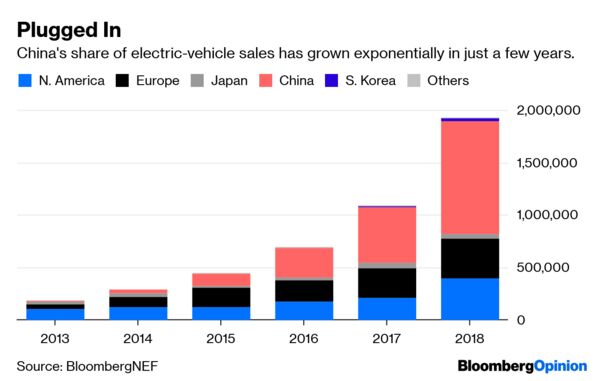Dan Wang
 Those who think China can’t catch up in innovation tend to base their arguments on abstractions: A rigid education system stifles creativity, they say, while heavy-handed industrial policies such as the “Made in China 2025” program encourage waste and inefficiency.
Those who think China can’t catch up in innovation tend to base their arguments on abstractions: A rigid education system stifles creativity, they say, while heavy-handed industrial policies such as the “Made in China 2025” program encourage waste and inefficiency.
Those skeptics are ignoring a far more concrete and relevant factor, however: the growing size and sophistication of China’s domestic market. The Chinese economy has expanded threefold since 2008, and tenfold since 2000. That makes it highly likely that China will develop leading technology companies. And it is nearly enough on its own to guarantee that China will join the ranks of technologically advanced countries.
To understand why, consider the example of wind turbines. China created the world’s largest wind-turbine market at the stroke of a pen with the government’s push to promote renewables. Many Chinese provinces are about as populous as large European countries; their procurement plans created enough internal competition to spur the buildup of globally competitive firms. According to Bloomberg New Energy Finance, severalChinese companies are now leading wind-turbine makers.
The market’s scale can even compensate for ineffective policy. China has a poor record of chip design and manufacturing, for instance, in spite of decades of government support and funding. In a generous interpretation, Chinese semiconductor capabilities are two generations (roughly five years) behind the leading edge.
Now, however, Chinese electronics companies — major customers for semiconductors — have grown dramatically in size and skill. Two decades ago, most such firms were doing assembly for Taiwanese PC makers. Today, Chinese brands such as Huawei Technologies Co. Ltd. and Lenovo Group Ltd. make up around 40 percent of the global market in smartphones and 25 percent in PCs. And cutting-edge products such as the consumer drone are increasingly conceived and manufactured in Shenzhen.
These companies are stronger partners for Chinese semiconductor firms. Chip-design companies such as Huawei’s HiSilicon Technologies Co. Ltd. currently have to use Taiwanese firms to manufacture leading-edge chips. But Chinese fabs now know that they have a good chance of winning Huawei’s business if they upgrade their technology. A large pool of local customers for Chinese fabs simply didn’t exist 20 years ago.
Something similar is happening in autos. Policymakers in Beijing recognize that their efforts to build strong car companies have mostly failed. Unlike Japan or Korea, China has produced no well-regarded automakers that can sell extensively abroad.
Instead of waiting for domestic manufacturers to catch up to leading global automakers, Beijing is thinking about the next step. The government has willed into existence the world’s largest market for electric vehicles through an array of policies that include subsidies for consumers, production quotas for automakers, and allowing drivers to purchase an EV immediately instead of waiting years for a license plate for an internal-combustion car. As a result, more than half of EV sales took place in China in 2018.

Even if most EVs sold on the mainland are still of low quality, the rates of entry by automakers and the levels of activity make it more likely that China will ultimately establish a strong position in the sector. For example, Nanjing-based Byton Ltd. was co-founded by a former BMW engineer from Germany, who cited the size of the market and policy support as reasons to be based in China. A huge market not only attracts entrepreneurs who are excited about the technology, but advances capital investments and encourages the creation of supply-chain clusters.
Of course, having a large pool of domestic customers can make firms lazy. South Korea’s industrial giants became globally competitive precisely because they couldn’t rely on their relatively small domestic market; they had to export quickly and compete against more advanced peers. For the most part, Chinese brands haven’t yet had to establish a similar presence abroad.
As Chinese consumers become richer and more discriminating, however, they’ll also demand higher quality. Remember that the U.S., too, became a major industrial and technological power by the early 20th century in part because of its enormous domestic market.
The potential for China’s industrial plans and innovative capacity has to be considered in the context of these changing conditions. A government-directed policy that failed in the past may well have a better chance of succeeding today. And the size of China’s market will be a better guide to judging its prospects than the softer measures we currently use.
No comments:
Post a Comment